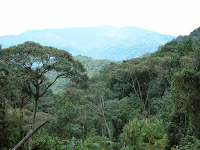 |
| Laurent Demuynck, CEO of Kigali Farms |
We arrive in Kigali where we meet up with
Laurent Demuynck, the founder and CEO of the company. He told us about the aims of his enterprise.
Kigali farms is a social profit making
enterprise that was set up in 2010.
Coming from an idea to reduce the level of malnutrition, they have
concentrated on mushrooms because they have a high nutritional value. The wild edible mushrooms of Rwanda
interested us from the beginning although they had never previously been
researched. Our ambition was to discover
the hidden treasures of the Rwandan forests which are eaten by the local
population
Our goal was to make Rwanda an example of
excellence when it comes to the cultivation of mushrooms.
We then make our way to the production
facility of Byumba where we meet Adriane Mukeshimana (production and quality
control manager) who will show us the various stages of production, starting
with the wild varieties collected by our mycologists. So let's follow the guide…
Purification
of the mycelium
A piece of mycelium is removed from the
collected mother material and transferred to a new Petri dish with agar
nutrient medium. This step takes place
under sterile conditions following a standard protocol. The mycelium can now start to grow.
Step 2
Step 3
Seeding
of the inoculum into grow bags
The
grow bags go to the incubator
The grow bags are stored in the dark in the
incubation room. These conditions
prevent the premature formation of fruiting bodies.
Step 5
The
grow bags are buried
 The grow bags are finally transferred to trays
containing soil. The air humidity is
kept at a constant 95% with a temperature of 18-22°C. Under these conditions we can shortly expect
fruiting bodies to develop on the surface of the soil. In this case Oyster mushrooms that can then
be harvested.
The grow bags are finally transferred to trays
containing soil. The air humidity is
kept at a constant 95% with a temperature of 18-22°C. Under these conditions we can shortly expect
fruiting bodies to develop on the surface of the soil. In this case Oyster mushrooms that can then
be harvested.
Hopefully the mushrooms which we collected
on our expedition will also grow here… but it’s far too soon to say… Fingers
crossed.



































